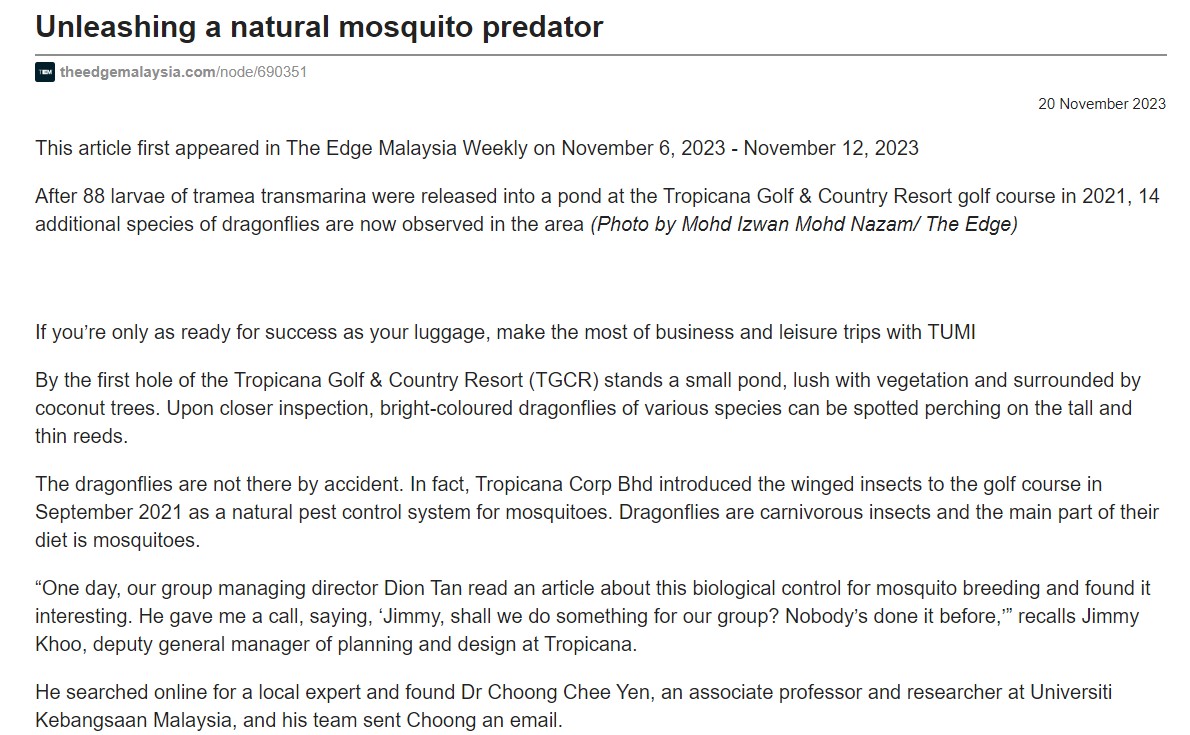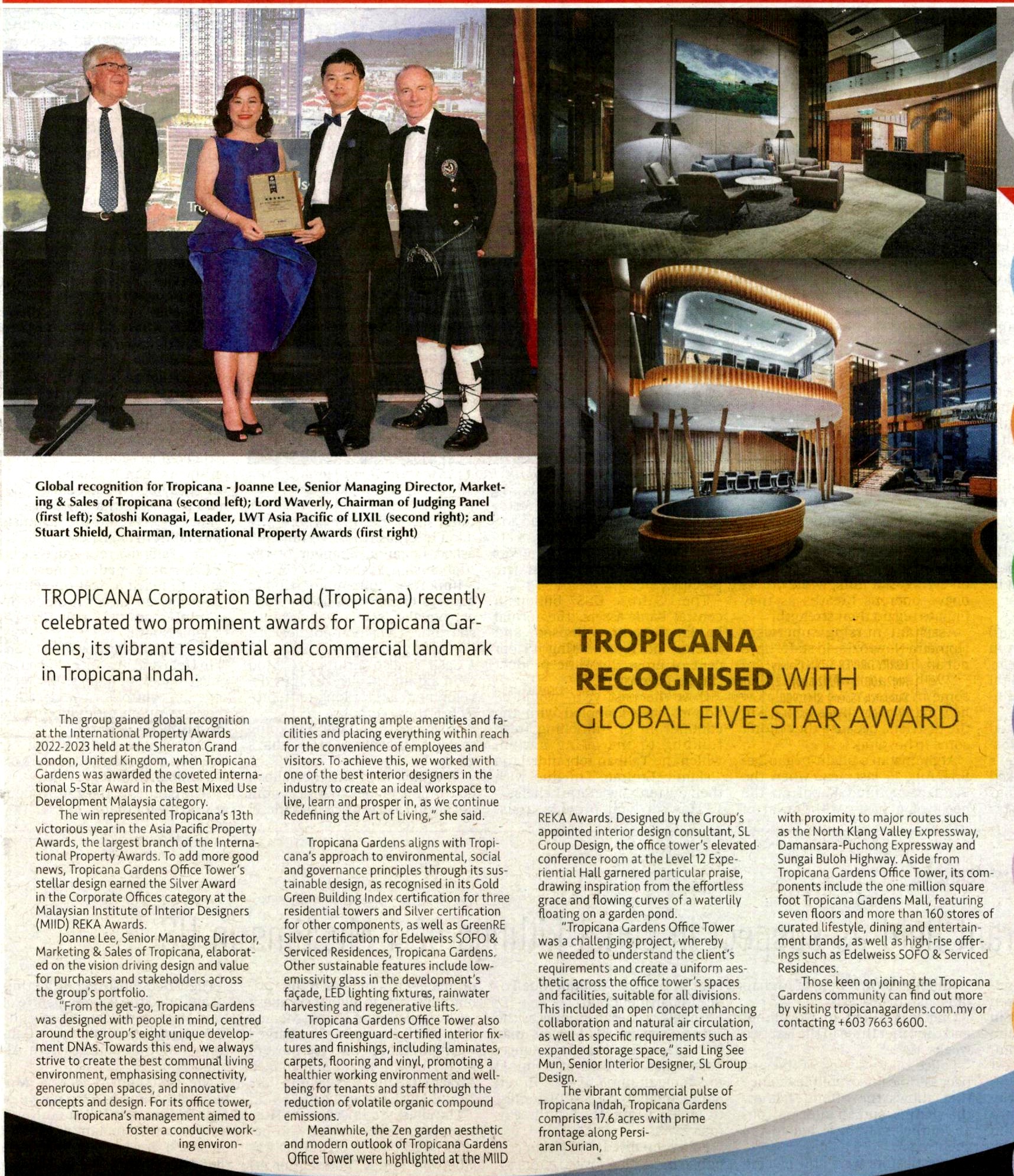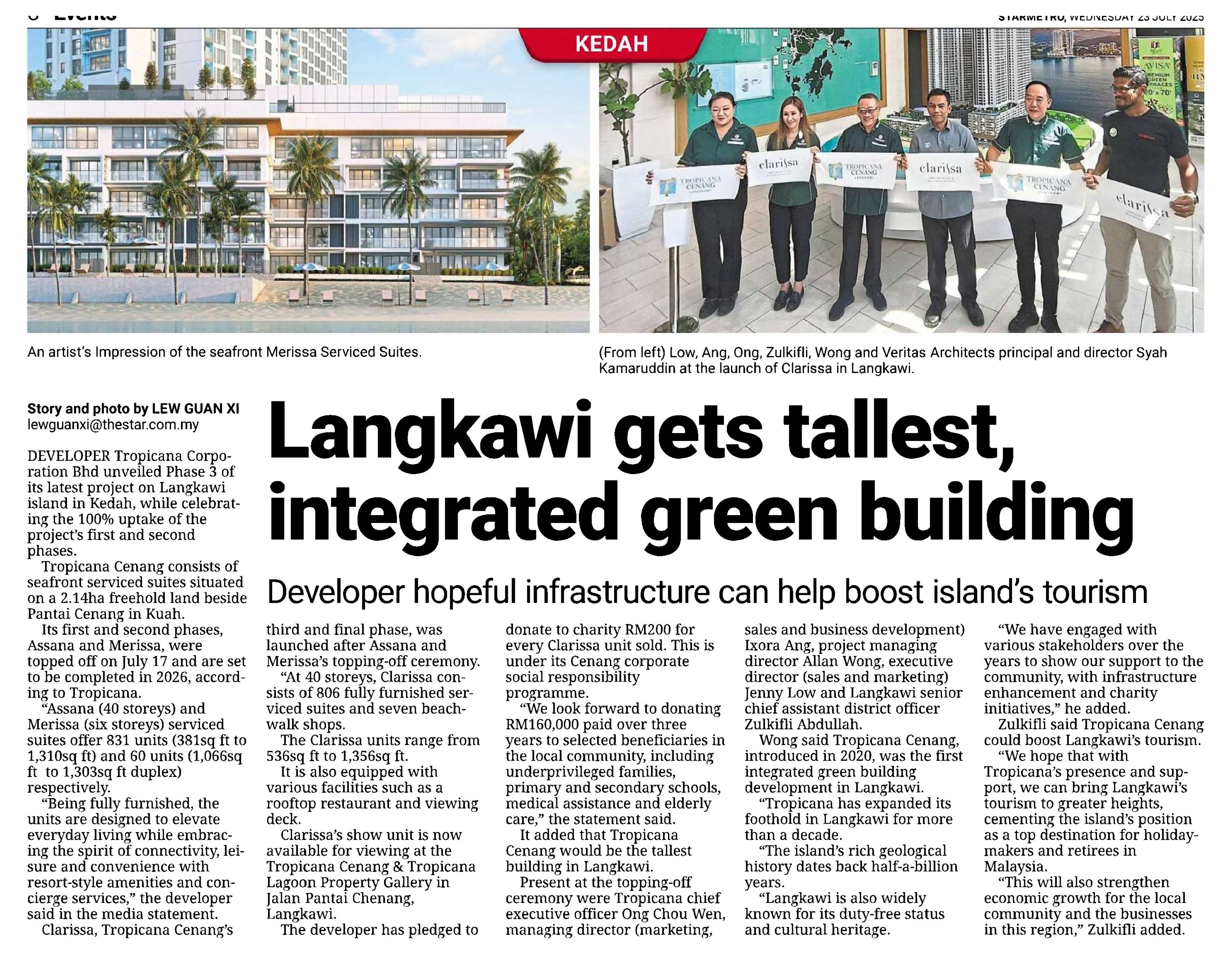The Edge Online - Property: Unleashing a natural mosquito predator

By the first hole of the Tropicana Golf & Country Resort (TGCR) stands a small pond, lush with vegetation and surrounded by coconut trees. Upon closer inspection, bright-coloured dragonflies of various species can be spotted perching on the tall and thin reeds.
The dragonflies are not there by accident. In fact, Tropicana Corp Bhd introduced the winged insects to the golf course in September 2021 as a natural pest control system for mosquitoes. Dragonflies are carnivorous insects and the main part of their diet is mosquitoes.
“One day, our group managing director Dion Tan read an article about this biological control for mosquito breeding and found it interesting. He gave me a call, saying, ‘Jimmy, shall we do something for our group? Nobody’s done it before,’” recalls Jimmy Khoo, deputy general manager of planning and design at Tropicana.
He searched online for a local expert and found Dr Choong Chee Yen, an associate professor and researcher at Universiti Kebangsaan Malaysia, and his team sent Choong an email.
Choong, who specialises in biodiversity and began studying dragonflies in 2005, was interested. He had never bred dragonflies in a man-made environment before. It was also a chance for him to apply his research on dragonfly larvae.
“I was thinking, why not? It’s a new experience initiated by a private entity,” says Choong.
In July 2020, a group was formed between Choong, Khoo and the TGCR’s landscaping team, which included senior horticulturist Mohd Suriga Md Sachari and general manager Ravindran Varnagopal.
They selected the site, which is near an existing lake. “Any water that overflows can go back into the lake … and the coconut trees can create some shade for the pond. After that, we started to dig a hole, put in liners and fill it up. We chose the plants after doing some research and receiving recommendations from Choong,” says Khoo.
“If you talk about challenges, it’s uncertainty. Nobody knows that it’s going to work. So, it’s a very interesting challenge for us. However, it’s something natural. Even if it doesn’t work out, it’s still aesthetically pleasing.”
Choong selected one out of 250 dragonfly species in Malaysia that can thrive in ponds. The Tramea transmarina (Saddlebag Gilder), which thrives on his university campus, was the chosen one. Choong captured the female adults and later released 88 of their larvae into the pond in September 2021.
Soon, the landscaping team began noticing dragonflies at the pond, including other species that they did not release. In February 2022, they invited Choong back to survey the results.
It was good news. Choong scooped the water from the pond and found the skin that the larvae shed when they grow. “That means the lifecycle is complete and the larvae we released survived to become flying adults,” says Choong, who included these results in his research paper.
Now, the team has observed 14 additional species of dragonflies at the pond. “We found larvae of other species as well. That means the pond is a good habitat. The larvae I found in February are not the larvae I released [in September]. It must be the larvae of a subsequent generation.”
GOING THE NATURAL WAY
The golf course has well-maintained water systems, so there isn’t a huge problem of mosquitoes breeding on the site, says Ravindran. While there hasn’t been a scientific study done to observe the impact on mosquito populations after the dragonflies were introduced, the team is confident that it has made a difference.
For one, the pond is near where the starters will sit from morning until evening by the first hole. “If there are any mosquito bites, they are the first victims. We don’t have that,” says Ravindran.
To really have an observable impact on the population of mosquitoes, more dragonflies will probably have to be released, adds Choong.
Since this project was successful, Tropicana is considering the possibility of replicating it in sales galleries, other club houses and potentially inside its property development projects.
“If there is a sales gallery, we can have a small corner and form a pond. At the same time, we can have some signage as an education effort. Visitors can bring their kids and we can educate them about this,” says Khoo.
“Most mosquito control efforts in Malaysia use pesticides or fogging, which is not natural.”
Adopting innovative and natural solutions is something that can be seen in other Tropicana projects as well. For instance, its Tropicana Metropark in Subang incorporated a bio-filtration system, a windmill and wetland plants into its lake features.
“The windmill converts wind energy to push water from the lake to the wetland cell and then back into the lake. It is energy saving because we don’t have to run the pump,” says Khoo. A natural wind tunnel was created during the development phase of the project.
These projects are a reflection of Tropicana’s environmental, social and governance commitments, says Yew Kong Chee, executive director at Tropicana. The company formed an ESG committee and aims to consider these elements in all its property developments going forward. Solar panels have already been installed in the club house and more will be put up in other Tropicana-owned buildings.
According to its 2022 annual report, Tropicana installed over 2,200 solar panels at TGCR’s clubhouse, which saved it up to RM174,959 in energy bills in 2022.
Biodiversity is another focus area for the company. For instance, in Tropicana Aman, Kota Kemuning, the company planted 4,000 samplings in the central park to create a diversified woodland, which would eventually become overlapped and interlinked tree canopies.
Many of Tropicana’s developments feature large water bodies that double as flood retention ponds, with wetland plants cultivated along the edges to improve the water quality.
For ESG initiatives to be successful, there must be support from the management and a team to lead these efforts, says Yew.
“We must have a team if we want to do it seriously and monitor it to make sure everything can grow well.”



